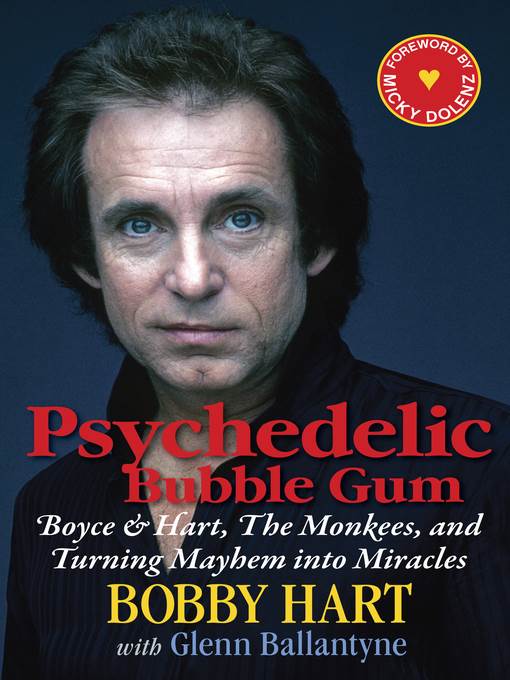
Psychedelic Bubble Gum
Boyce & Hart, The Monkees, and Turning Mayhem into Miracles
کتاب های مرتبط
- اطلاعات
- نقد و بررسی
- دیدگاه کاربران
نقد و بررسی

June 29, 2015
Hart, half of a songwriting duo that crafted hundreds of 1960s and '70s pop hits and gave the made-for-TV band the Monkees their signature theme song and "Last Train to Clarksville," aims to inspire readers' creativity with this earnest but not terribly interesting autobiography. Fans of mass-produced pop will be pleased to read about Hart's early songwriting days, which gave the world "Come a Little Bit Closer," a great hit for the long-ago Jay and the Americans, and led to a gig (with writing partner Tommy Boyce) supplying tunes for the "Pre-Fab Four." Apart from an engaging discussion of both songwriting and the technical production aspects of some of his Monkees work, there's little exploration of the songwriting craft. Instead, Hart piles on plenty of earnest, cheery aphorisms about creativity, offered in several lists of maxims, helpful hints, and inspirational sayings. These include "Your Thoughts Create Your Reality" and other distillations of the teachings of Paramahansa Yogananda, a book whose influence Hart cites throughout his ghostwritten account. Readers may appreciate the brief look at the mid-1960s machinery of creating mass musical entertainment, but there's not much else that will keep anyone but a deeply dedicated fan turning the pages.

Hart, in his debut, tells of how his jagged path through the music industry led to heartbreak-but also to happiness.This snappy yet reflective memoir opens with an episode that's emblematic of its narrator. While struggling to make it in Hollywood, he listened to the radio and detected an unsatisfying insincerity in the DJ's voice. Hart's desire for authenticity, and his connections in entertainment, would go on to propel him on a remarkable journey through the music world. He left his hometown of Phoenix to start six months of active duty in the U.S. Army Reserve in Monterey, California, and soon found himself entangled in the glamour and grit of Hollywood-that "circus of extremes for the senses with its bright lights and colorful characters"-while working for a company that manufactured labels for vinyl records. His own recording career, though, began one fateful Saturday, when he booked studio time for himself and became amazed at the possibilities that emerged when he combined his musical background with skillful sound engineering. What followed were years of risk and uncertainty, and powerful collaborations with other musicians-as well as love, loss, and friendship. Hart candidly depicts his hyperactive, out-and-about lifestyle as a musician and songwriter who struggled to balance the work that gave his life meaning with his commitment to his family. Sometimes the strain proved too much, and his relationship with his first wife deteriorated as a result. Along the way, countless projects with his songwriting partner, Tommy Boyce, rolled by, as did the tumultuous cultural and historical events of the 1960s. Before long, the duo was writing songs for The Monkees, including "(Theme from) The Monkees," "Last Train to Clarksville," and "Valleri." In the memoir's most captivating pages, Hart recounts the stratospheric rise of that artificially engineered musical group. Particularly engaging are Hart's anecdotes about his own songwriting process; he recounts, for instance, that the song fragment that eventually became "Last Train to Clarksville" was inspired by a mishearing of the Beatles' 1966 single "Paperback Writer."A highly detailed autobiography by a unique figure in American cultural history, which will interest historians and pop-culture aficionados alike. COPYRIGHT(1) Kirkus Reviews, ALL RIGHTS RESERVED.

May 1, 2015
Hart's name may not resonate much with anyone born after the baby boom generation, but for much of the 1960s he was a prolific and popular artist and songwriter. Touching only briefly on his early years as the shy son of a minister, Hart tells the story of a young man struggling to succeed in the music industry. Not surprisingly, a significant portion of the book focuses on his two most enduring industry relationships. The first is with his singing and songwriting partner Tommy Boyce (1939-94) and the other is with the Monkees, for whom he and Boyce wrote a number of hits ("Last Train to Clarksville," "Valleri"), including the group's theme song. Hart writes about his interactions with many famous musicians but it never feels like he's name-dropping, and he rarely has anything negative to say about his peers or his experiences. In the end, he comes off as a guy who fought hard for success and who appreciates what life has given him. VERDICT Hart's work may not be of interest to a huge audience, but his insights and experience will prove satisfying to fans of music history and those who love the music of the author's era.--Craig L. Shufelt, Fort Erie P.L., Ont.
Copyright 2015 Library Journal, LLC Used with permission.

























دیدگاه کاربران